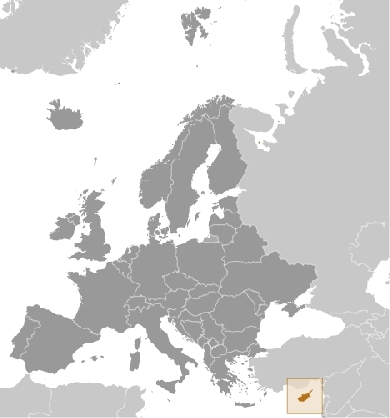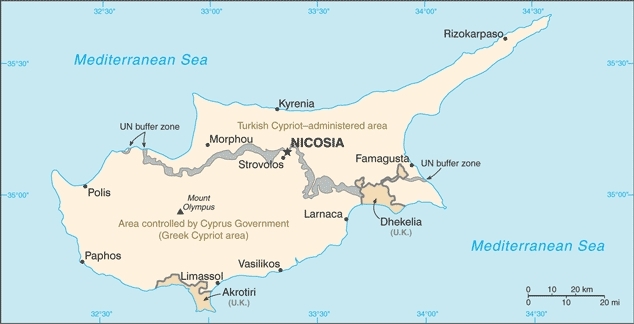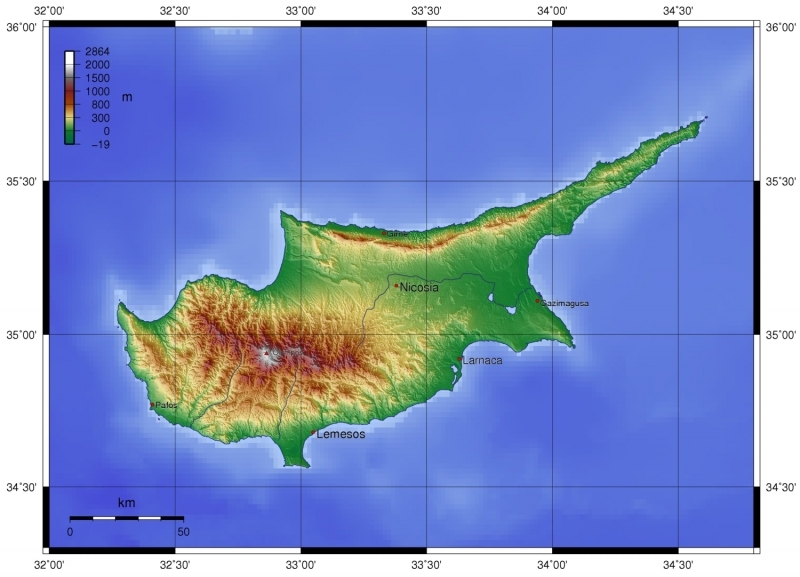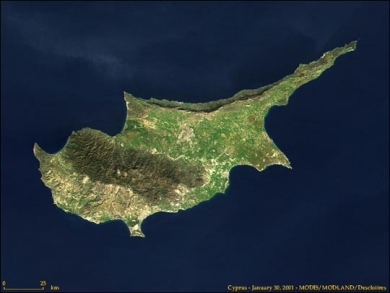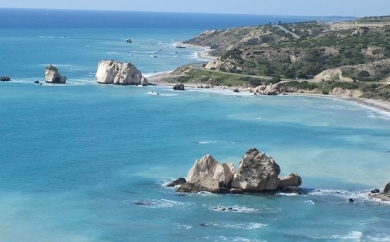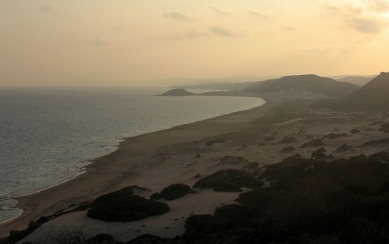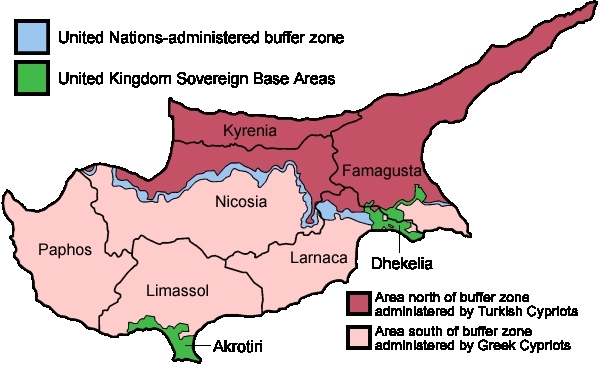Cyprus
Countries and Regions of the World Collection  Cyprus is a divided island nation of about 1.1 million people in the Mediterranean Sea, south of Turkey. It is the third largest island in the Mediterranean Sea (after Sicily and Sardinia).
Cyprus is a divided island nation of about 1.1 million people in the Mediterranean Sea, south of Turkey. It is the third largest island in the Mediterranean Sea (after Sicily and Sardinia).
Hostilities in 1974 divided the island into two de facto autonomous entities, the internationally recognized Cypriot Government and a Turkish-Cypriot community (north Cyprus); the 1,000-strong UN Peacekeeping Force in Cyprus (UNFICYP) has served in Cyprus since 1964 and maintains the buffer zone between north and south;
Its major environmental issues include:
- water resource problems (no natural reservoir catchments, seasonal disparity in rainfall, sea water intrusion to island's largest aquifer, increased salination in the north);
- water pollution from sewage and industrial wastes;
- coastal degradation; and,
- loss of wildlife habitats from urbanization.
Cyprus is susceptible to moderate earthquake activity and droughts.
By 8200 BC Cyprus had settled villages and the island is home to the world’s oldest known water wells—dating from between 9,000 and 15,000 years ago.
A former British colony, Cyprus became independent in 1960 following years of resistance to British rule.
Tensions between the Greek Cypriot majority and Turkish Cypriot minority came to a head in December 1963, when violence broke out in the capital of Nicosia. Despite the deployment of UN peacekeepers in 1964, sporadic intercommunal violence continued forcing most Turkish Cypriots into enclaves throughout the island.
In 1974, a Greek (Greece) Government-sponsored attempt to seize control of Cyprus was met by military intervention from Turkey, which soon controlled more than a third of the island. In 1983, the Turkish Cypriot-occupied area declared itself the "Turkish Republic of Northern Cyprus" ("TRNC"), but it is recognized only by Turkey.
The election of a new Cypriot president in 2008 served as the impetus for the UN to encourage both the Greek Cypriot and Turkish Cypriot communities to reopen unification negotiations. In September 2008, the leaders of the two communities began negotiations under UN auspices aimed at reuniting the divided island; the talks remain ongoing.
The entire island entered the European Union on 1 May 2004, although the EU acquis - the body of common rights and obligations - applies only to the areas under the internationally recognized government, and is suspended in the areas administered by Turkish Cypriots. However, individual Turkish Cypriots able to document their eligibility for Republic of Cyprus citizenship legally enjoy the same rights accorded to other citizens of European Union states.
The area of the Republic of Cyprus under government control has a market economy dominated by the service sector, which accounts for nearly four-fifths of GDP. Tourism, financial services, and real estate are the most important sectors.
Erratic growth rates over the past decade reflect the economy's reliance on tourism, the profitability of which often fluctuates with political instability in the region and economic conditions in Western Europe. Nevertheless, the economy in the area under government control has grown at a rate well above the EU average since 2000.
Turkey protests Cypriot Government creating hydrocarbon blocks and maritime boundary with Lebanon in March 2007
Contents
Geography
Location: Middle East, island in the Mediterranean Sea, south of Turkey
Geographic Coordinates: 35 00 N, 33 00 E
Area: 9,251 sq km (of which 3,355 sq km are in north Cyprus) (land: 9,241 sq km; water: 10 sq km)
Land Boundaries: 150.4 km (approximately) with two British border sovereign base areas: Akrotiri 47.4 km, Dhekelia 103 km (approximately)
Coastline: 648 km
Maritime Claims:
territorial sea: 12 nm
contiguous zone: 24 nm
continental shelf: 200 m depth or to the depth of exploitation
Natural Hazards: moderate earthquake activity; droughts
Terrain: central plain with mountains to north and south; scattered but significant plains along southern coast. The highest point is Mount Olympus (1,951 m)
Climate: temperate; Mediterranean with hot, dry summers and cool winters
Topography of Cyprus. Source: Wikimedia Commons
The part of the Mediterranean Sea surrounding Cyprus is known as the Levantine Sea.
Ecology and Biodiversity
The Cyprus Mediterranean forests ecoregion covers the island. Located in the Mediterranean Sea, this island ecoregion is home to a variety of flora and fauna. More than 125 endemic plants are found here including the endangered Cyprus cedar (Cedrus brevifolia) and the Cyprus oak (Quercus alnifolia). The island also serves as a stepping stone between Europe and Africa for millions of migratory birds every year. Over 350 species of birds can be found here, most of which are migratory. Some 46 residents and 27 migratory species breed regularly on the island; about 10 species are endemic. The island is home to a number of mammals such as the Cyprus moufflon (Ovis orientalis ophion), which is a rare type of wild sheep found only on the island of Cyprus. Only eighteen percent of the island is covered by its original habitat. Conversion of forest to pastures, urban development, forest fires, and tourism are all causes of habitat loss and continue to be a threat to this ecoregion.
See also: Biological diversity in the Mediterranean Basin and Value of Mediterranean forests
People and Society
Population: 1,138,071 (July 2012 est.)
Since 1974, Cyprus has been divided de facto into the government-controlled two-thirds of the island and the remaining one-third of the island, which is administered by Turkish Cypriots. Greek and Turkish Cypriots share many customs but maintain distinct identities based on religion, language, and close ties with their respective "motherlands." Greek is predominantly spoken in the south, Turkish in the north. English is widely used. Cyprus has a well-developed system of primary and secondary education. The majority of Cypriots earn their higher education at Greek, Turkish, British, and other European or American universities. Both the Greek Cypriot and Turkish Cypriot communities have developed private colleges and publicly supported universities.
Ethnic groups: Greek 77%, Turkish 18%, other 5% (2001)
|
This image, acquired by NASA’s Moderate-resolution Imaging Spectroradiometer (MODIS) on January 30, 2001, shows the three distinct geologic regions of the island. In the central and western part of the island is the Troödos Massif, a mountain range whose surface layer is mostly basaltic lava rock, and whose maximum elevation is 1953m. Running in a thin arc along the northeast margin of the island is Cyprus’ second mountain range, a limestone formation called the Kyrenia Range. A flat area of low relief occupies the space between these ranges, and is home to Lefkosia, the capital city of the Republic of Cyprus. The city is visible as a grayish-brown patch near the image’s center. Lefkosia lies along a UN-patrolled cease fire line that begins in roughly the center of the W-shaped northwestern coastline and meanders east/southeast across the island. The line was established in 1974, and it divides the Turkish-occupied North from the Republic of Cyprus to the south. |
| Winter view of the forest of Chionistra in the Troödos Massif. Source: Wikimedia Commons. |
| Petra Tou Romiou (Rock of the Greek), or Aphrodite's Rock, is a sea stack in Pafos, in Western Cyprus. Source:Wikimedia Commons |
| Karpass Peninsula in the northeast of Cyprus. Source: Franco Pecchio/Flickr |
Age Structure:
0-14 years: 16.2% (male 93,280/female 88,022)
15-64 years: 73.4% (male 427,752/female 394,578)
65 years and over: 10.4% (male 50,761/female 66,096) (2011 est.)
Population Growth Rate: 1.571% (2012 est.)
Birthrate: 11.44 births/1,000 population (2012 est.)
Death Rate: 6.48 deaths/1,000 population (July 2012 est.)
Net Migration Rate: 10.75 migrant(s)/1,000 population (2012 est.)
Life Expectancy at Birth: 78 years
male: 75.21 years
female: 80.92 years (2012 est.)
Total Fertility Rate: 1.45 children born/woman (2012 est.)
Languages: Greek (official), Turkish (official), English
Literacy: (age 15 and over can read and write): 97.6% (2001 census)
Urbanization: 70% of total population (2010) growing at an annual rate of change of 1.3% (2010-15 est.)
History
Human settlement on Cyprus stretches back nearly eight millennia and by 3700 BC, the island was a crossroads between East and West. The island fell successively under Assyrian, Egyptian, Persian, Greek, and Roman domination. For 800 years, beginning in 364 AD, Cyprus was ruled by Byzantium. After brief possession by King Richard I (the Lion-Hearted) of England during the Crusades, the island came under Frankish control in the late 12th century. It was ceded to the Venetian Republic in 1489 and conquered by the Ottoman Turks in 1571. The Ottomans applied the millet system to Cyprus, which allowed religious authorities to govern their own non-Muslim minorities. This system reinforced the position of the Orthodox Church and the cohesion of the ethnic Greek population. Most of the Turks who settled on the island during the 3 centuries of Ottoman rule remained when control of Cyprus--although not sovereignty--was ceded to Great Britain in 1878. Many, however, left for Turkey during the 1920s. The island was annexed formally by the United Kingdom in 1914 at the outbreak of World War I and became a crown colony in 1925.
Cyprus gained its independence from the United Kingdom and established a constitutional republic in 1960, after an anti-British campaign by the Greek Cypriot EOKA (National Organization of Cypriot Fighters), a guerrilla group that desired political union, or enosis, with Greece. Archbishop Makarios, a charismatic religious and political leader, was elected president.
Shortly after the founding of the republic, serious differences arose between the two communities about the implementation and interpretation of the constitution. The Greek Cypriots argued that the complex mechanisms introduced to protect Turkish Cypriot interests were obstacles to efficient government. In November 1963, President Makarios advanced a series of constitutional amendments designed to eliminate some of these special provisions. The Turkish Cypriots opposed such changes. The confrontation prompted widespread intercommunal fighting in December 1963, after which Turkish Cypriots ceased to participate in the government. Following the outbreak of intercommunal violence, many Turkish Cypriots (and some Greek Cypriots) living in mixed villages began to move into enclaved villages or elsewhere. UN peacekeepers were deployed on the island in 1964. Following another outbreak of intercommunal violence in 1967-68, a Turkish Cypriot provisional administration was formed.
In July 1974, the military junta in Athens sponsored a coup led by extremist Greek Cypriots against the government of President Makarios, citing his alleged pro-communist leanings and his perceived abandonment of enosis. Turkey, citing the 1960 Treaty of Guarantee, intervened militarily to protect Turkish Cypriots.
In a two-stage offensive, Turkish troops took control of 38% of the island. Almost all Greek Cypriots subsequently fled south while almost all Turkish Cypriots moved to the north. Since the events of 1974, UN peacekeeping forces have maintained a buffer zone between the two sides. Except for occasional demonstrations or infrequent incidents between soldiers in the buffer zone, the island was free of violent conflict from 1974 until August 1996, when violent clashes led to the death of two demonstrators and escalated tension. The situation has been quiet since 1996.
Attempts To Achieve a Cyprus Settlement
The first UN-sponsored negotiations to develop institutional arrangements acceptable to both communities began in 1968; several sets of negotiations and other initiatives followed. In general, Turkish Cypriots focus on bizonality, security guarantees, and political equality between the two communities, envisioning a weak federation with strong powers reserved for the two constituent states. Greek Cypriots, on the other hand, emphasize the rights of movement, property, settlement, and the return of territory, and envision a stronger, more integrated federal government. Numerous UN-sponsored negotiation rounds have faltered owing to the sides’ differing aims and wants, the last major failure being the 2004 “Annan Plan,” which in simultaneous referenda in the two communities won the support of two-thirds of Turkish Cypriots but only one-fourth of Greek Cypriots.
For 2 years following the Annan Plan defeat, the island saw little progress toward reunification until a visiting high-level UN official in July 2006 secured the sides’ support for a framework agreement aimed at restarting settlement discussions. The sides tackled procedural issues over the ensuing 18 months but mainly avoided substance. A breakthrough of sorts occurred with the February 2008 election of Republic of Cyprus President Demetris Christofias, who immediately pledged to renew settlement efforts under UN auspices. Christofias and then-Turkish Cypriot leader Mehmet Ali Talat met four times between March and July 2008, with their chief negotiators and technical experts supporting their efforts via more frequent gatherings. In July 2008, the two leaders announced the decision to proceed to full-fledged negotiations, which began on September 3, 2008.
Over the next 16 months, Christofias and Talat met more than 60 times, tackling the core negotiation issues of governance and power sharing, property, the economy, EU matters, security and guarantees, territorial arrangements, and migration issues. UN Secretary General Ban Ki-moon paid an official visit to Cyprus January 31-February 2, 2010. He congratulated the sides for progress to date and emphasized that courage and determination would be needed to bring the talks to a successful conclusion. After Dervis Eroglu defeated Mehmet Ali Talat to become the Turkish Cypriot leader in April 2010, negotiations resumed in May 2010. Christofias and Eroglu continue to meet, including on five occasions in a tripartite forum with the UN Secretary General.
Bi-Communal Contact, Crossing Procedures
In April 2003, then-leader of the Turkish Cypriots Rauf Denktash relaxed many restrictions on individuals crossing between the two communities leading to relatively unimpeded bi-communal contact for the first time since 1974. Since the relaxation, there have been about 18 million buffer zone crossings in both directions. Under the current regulations, Greek Cypriots must present identity documents to cross to the area administered by Turkish Cypriots, something many are reluctant to do. They are able to drive their personal vehicles in the area administered by Turkish Cypriots, provided they first obtain a policy from a Turkish Cypriot insurance provider. Turkish Cypriots are permitted to cross into the government-controlled area upon presentation of a Turkish Cypriot ID card or other identity documentation acceptable to Republic of Cyprus authorities. They must also obtain car insurance from an insurer in the government-controlled area to drive their personal vehicles there.
European Union (EU)
Along with the Czech Republic, Estonia, Hungary, Latvia, Lithuania, Malta, Poland, Slovakia, and Slovenia, the Republic of Cyprus entered the EU on May 1, 2004. The EU acquis communautaire is suspended in the area administered by Turkish Cypriots pending a Cyprus settlement. Cyprus adopted the Euro on January 1, 2008.
Government
Since 1974, Cyprus has been divided de facto into the government-controlled two-thirds of the island and the Turkish Cypriot-administered one-third. The Government of the Republic of Cyprus has continued to be the only internationally recognized authority; in practice, its authority extends only to the government-controlled area.
The 1960 Cypriot constitution provided for a presidential system of government with independent executive, legislative, and judicial branches, as well as a complex system of checks and balances, including a weighted power-sharing ratio designed to protect the interests of the Turkish Cypriots. The executive, for example, was headed by a Greek Cypriot president and a Turkish Cypriot vice president, elected by their respective communities for 5-year terms, and each possessing a right of veto over certain types of legislation and executive decisions. The Greek Cypriot-controlled Republic of Cyprus retains most elements of the presidential system of government expressed in the constitution, although it has cited the Turkish Cypriots' "withdrawal from government" and the "law of necessity" to enact structural changes that allow "effective governance."
Following the 1974 hostilities, the Turkish Cypriots set up their own institutions in the area they administered with an elected "president" and a "prime minister" responsible to the “National Assembly” exercising joint executive powers. In 1983, the Turkish Cypriots declared an independent "Turkish Republic of Northern Cyprus" ("TRNC"). The United States does not recognize the "TRNC," nor does any country other than Turkey.
Government Type: Republic. Note: a separation of the two ethnic communities inhabiting the island began following the outbreak of communal strife in 1963; this separation was further solidified after the Turkish intervention in July 1974, following a Greek military-junta-supported coup attempt that gave the Turkish Cypriots de facto control in the north; Greek Cypriots control the only internationally recognized government; on 15 November 1983 Turkish Cypriot "President" Rauf Denktash declared independence and the formation of a "Turkish Republic of Northern Cyprus" ("TRNC"), which is recognized only by Turkey
Capital: Nicosia (population 240,000 est. 2009)
Administrative divisions: 6 districts; Famagusta, Kyrenia, Larnaca, Limassol, Nicosia, Paphos; note - Turkish Cypriot area's administrative divisions include Kyrenia, all but a small part of Famagusta, and small parts of Nicosia (Lefkosia) and Larnaca
Administrative divisions of Cyprus. Source: Golbez/Wikipedia
Independence Date: 16 August 1960 (from the UK); note - Turkish Cypriots proclaimed self-rule on 13 February 1975 and independence in 1983, but these proclamations are only recognized by Turkey
Legal System: mixed legal system of English common law and civil law with Greek Orthodox religious law influence. Cyprus accepts compulsory International Court of Justice (ICJ) jurisdiction with reservations; and, accepts International criminal court (ICCt) jurisdiction
International Environmental Agreements
Cyprus is party to international agreements on: Air Pollution, Air Pollution-Nitrogen Oxides, Air Pollution-Persistent Organic Pollutants, Air Pollution-Sulfur 94, Biodiversity, Climate Change, Climate Change-Kyoto Protocol, Desertification, Endangered Species, Environmental Modification, Hazardous Wastes, Law of the Sea, Marine Dumping, Ozone Layer Protection, Ship Pollution, and Wetlands
Water
Total Renewable Water Resources: 0.4 cu km (2005)
Freshwater Withdrawal: 0.21 cu km/yr (27% domestic, 1% industrial, 71% agricultural):
Per Capita Freshwater Withdrawal: 250 cu m/yr (2000)
Agriculture
Agricultural products: citrus, vegetables, barley, grapes, olives, vegetables; poultry, pork, lamb; dairy, cheese
(in Turkish Cypriot area) area citrus fruit, dairy, potatoes, grapes, olives, poultry, lamb
Irrigated Land: 460 sq km (2008)
Resources
Natural Resources: copper, pyrites, asbestos, gypsum, timber, salt, marble, clay earth pigment
Land Use:
arable land: 10.81%
permanent crops: 4.32%
other: 84.87% (2005)
Economy
Cyprus has an open, free-market, services-based economy with some light manufacturing. Cyprus' accession as a full member to the European Union as of May 1, 2004, has been an important milestone in its recent economic development. The Cypriots are among the most prosperous people in the Mediterranean region, with a per capita income rapidly approaching 100% of the EU 27 average. Internationally, Cyprus promotes its geographical location as a "bridge" between three continents, along with its educated English-speaking population, good airline connections, and telecommunications.
In the past 20 years, the economy has shifted from agriculture and light manufacturing to services. Currently, agriculture makes up only 2.3% of the GDP and employs 7.4% of the labor force. Industry, mining, and construction contribute 16.5% and employ 19.3% of the labor force. The services sector, including tourism, contributes 81.2% to the GDP and employs 73.3% of the labor force. In recent years, the services sector, and financial services in particular, have provided the main impetus for growth, while tourism has been declining in importance. Manufactured goods account for 58.3% of domestic exports, while potatoes and citrus constitute the principal export crops. The island has few proven natural resources, although it is now gearing up for exploration for natural gas off its southern coast. Trade is vital to the Cypriot economy and most goods are imported. The trade deficit reached $7.0 billion in 2010. Cyprus must import fuels, most raw materials, heavy machinery, and transportation equipment. More than 68.8% of its imports come from the European Union, particularly Greece, Italy, and Germany, while 1.4% come from the United States.
Cyprus has been a member of the Eurozone since January 1, 2008, when it replaced the Cyprus pound with the Euro. The final conversion exchange rate between the Cypriot pound and the Euro was one Euro per 0.585274 Cyprus pounds. The following website offers additional information on the mechanics of Cyprus's adoption of the Euro: http://www.euro.cy/
In 2010, the Cypriot economy expanded by 1.0%, buoyed by a rebound in tourism and financial services, following a 1.7% contraction in 2009 in the aftermath of the global financial crisis. However, Cyprus' path to recovery is still fraught with difficulties. Structural rigidities in the labor market undermine Cyprus' competitiveness in most sectors, while a bloated civil service poses special challenges. Tourism, once the engine of growth for the island, has been stagnating over the last decade, facing stiff competition from the region. Most analysts agree that Cyprus will find it difficult to reach growth rates in excess of 2.0%-2.5% in the coming years--considerably lower than the 4.0% growth average recorded in the decade preceding the 2009 crisis.
The state payroll represents about 30% of public spending annually. The government pledged to engage civil service unions in a discussion to effect wide-ranging cutbacks, including seeking union agreement on shaving €70 million (approx. $96 million) off the civil service payroll over 2 years (2011 and 2012) and discussing civil service pension reform. Civil service employees do not contribute toward their own pensions, but this may have to change in order to safeguard the long-term viability of the social security system.
In recent months (as of March 2012), all three major credit rating agencies have downgraded Cyprus (both its sovereign debt and its main banks) over concerns of fiscal slippage and exposure of the Cypriot financial system to the Greek market and debt. These downgrades effectively place Cyprus only marginally above the Eurozone's most troubled countries (Greece, Portugal, and Ireland). Inflation remained stubbornly above the average EU 27 level at 2.6% in 2010, a trend continuing in 2011. Unemployment remains below the average EU level, but its current level of over 7.0% is a 35-year high for Cyprus.
Investment Climate
In the run-up to EU accession (May 1, 2004), Cyprus dismantled most investment restrictions, attracting increased flows of foreign direct investment (FDI), particularly from the EU. According to the United Nations Conference on Trade and Development (UNCTAD) "World Investment Report 2009," Cyprus ranked among the world leaders in terms of attracting foreign direct investment on a per capita basis. The World Economic Forum's Competitiveness Index ranked Cyprus 40th among 139 economies in 2010-2011. The Heritage Foundation and the Wall Street Journal 2010 Index of Economic Freedom ranked Cyprus the 24th freest economy in the world. Transparency International also ranked Cyprus among the top 28 countries on transparent procedures in 2010. Non-EU investors (both natural and legal persons) are free to invest in Cyprus in most sectors, either directly or indirectly (including all types of portfolio investment in the Cyprus Stock Exchange). The only exceptions concern primarily the acquisition of property and, to a lesser extent, restrictions on investment in the sectors of tertiary education, banking, and mass media.
In 2009, the inflow of FDI (including “brass plate” companies) reached U.S. $6.0 billion. About 90% of this investment came from the broad region of Europe, including 36.6% from the Russian Federation. In terms of sectoral allocation, incoming FDI in 2009 went to the following sectors: financial intermediation 58.1%; trade and repairs 23.7%; and real estate and business activities 15.7%.
The flow of U.S. investment in Cyprus reached U.S. $101.3 million in 2009, or 1.7% of Cyprus' total inward FDI. The stock of U.S. investment in the island was U.S. $248.8 million at the end of 2009. Projects involving U.S. investment in recent years have included real estate and various business activities, including a well-known U.S. coffee retailing franchise, a university, an information technology firm, an equestrian center, a hair products manufacturing unit, a firm trading in health and natural foodstuffs, an oil field products manufacturer, and a financial services company. U.S. investors may benefit from Cyprus’s abolition of EU-origin investment restrictions, provided they operate through EU subsidiaries.
Turkish Cypriot Economy
The Turkish Cypriot economy has roughly half the per capita GDP of the south, and economic growth tends to be volatile, given the north's relative isolation, bloated public sector, reliance on the Turkish lira, and small market size. The Turkish Cypriots are heavily dependent on transfers from the Turkish Government. Ankara directly finances about one-third of the Turkish Cypriot "administration's" budget. Aid from Turkey has exceeded $400 million annually in recent years.
The EU acquis communautaire has been temporarily suspended in the northern part of the island due to the unresolved political situation. The currency used is the Turkish Lira, although Euros are widely accepted. The economy of the Turkish Cypriot-administered area is dominated by the services sector including the public sector, trade, tourism, and education, with smaller agriculture and light manufacturing sectors. The economy operates on a free-market basis, although it continues to be handicapped by the political isolation of Turkish Cypriots, the lack of private and public investment, high freight costs, and shortages of skilled labor. Despite these constraints, the Turkish Cypriot economy turned in an impressive performance from 2003 to 2006, with estimated growth rates of 13.2% in 2006, 13.5% in 2005, 15.4% in 2004, and 11.4% in 2003. This growth was fueled largely by a construction boom, which ended abruptly amid renewed controversy over the legitimacy of property titles in the north, following a much-publicized court case in which the United Kingdom Court of Appeal on January 19, 2010 affirmed an earlier ruling by the European Court of Justice. The global financial crisis has hit the Turkish Cypriot economy hard; leading to negative growth rates of 6.3% in 2009, and 3.4% in 2008. Tourism and tertiary education are two very important sectors.
The Turkish Cypriot economy benefits by the employment of around 6,000 Turkish Cypriots in the Greek Cypriot economy where wages are significantly higher, and by the relative stability of the Turkish Lira (prior to 2008). In 2008, the services sector accounted for 77% of GDP, industry and construction accounted for 18% of GDP, and agriculture 5%, according to Turkish Cypriot statistics. The partial lifting of travel restrictions between the two parts of the island in April 2003 has allowed movement of persons--around 18 million crossings to date--between the two parts of the island with no significant interethnic incidents.
Turkey remains, by far, the main trading partner of the area administered by Turkish Cypriots, supplying 70% of imports and absorbing around 50% of exports (2008 figures). In another landmark case, the European Court of Justice ruled in 1994 against the British practice of importing produce from the area based on certificates of origin and phytosanitary certificates granted by "TRNC" authorities. This decision resulted in a considerable decrease of Turkish Cypriot exports to the EU--from $36.4 million (or 66.7% of total Turkish Cypriot exports) in 1993 to $17.2 million in 2008 (or 20.5% of total exports). In August 2004, new EU rules allowed goods produced or substantially transformed in the area administered by Turkish Cypriots to be sold duty-free to consumers in the government-controlled area and through that area to the rest of the EU. To qualify, goods must also meet EU sanitary/phytosanitary requirements. Animal products are excluded from this arrangement. In 2005, Turkish Cypriot authorities adopted a new regulation "mirroring" the EU rules and allowing certain goods produced in the government-controlled areas to be sold in the area administered by Turkish Cypriots. (However, suppliers cannot legally transport imported products over the green line in either direction.) Despite these efforts, direct trade between the two communities remains limited (comprising only 0.09% of the Greek Cypriot community’s trade, and 11.8% of the Turkish Cypriot community’s trade in February 2009).
The EU continues to be the second-largest trading partner of the area administered by Turkish Cypriots, with a 14.1% share of total imports and 20.5% share of total exports. Total imports increased to $1.7 billion in 2008, while total exports remained at $83.7 million. Imports from the U.S. reached $11.7 million in 2008, while exports to the U.S. were nil.
Assistance from Turkey is crucial to the Turkish Cypriot economy. Under the economic protocol signed in 2006, Turkey undertook to provide Turkish Cypriots financial assistance totaling 1.875 billion New Turkish Lira (YTL--roughly $1.34 billion) over a 3-year period (600 million YTL in 2007, 625 million YTL in 2008, and 650 million YTL in 2009). Turkey also provides millions of dollars annually in the form of low-interest loans mostly to Turkish entrepreneurs in support of export-oriented industrial production and tourism. The total amount of Turkish assistance to Turkish Cypriots since 1974 is estimated to be more than $4 billion.
| Republic of Cyprus | Turkish Cypriot area | |
| GDP: (Purchasing Power Parity): | $$23.77 billion (2011 est.) | $1.829 billion (2007 est.) |
| GDP: (Official Exchange Rate): | $25.7 billion (2011 est.) | |
| GDP- per capita (PPP): | $29,100 (2011 est.) | $11,700 (2007 est.) |
| GDP- composition by sector: |
agriculture: 2.3% |
agriculture: 8.6%, industry: 22.5%, services: 69.1% (2006 est.) |
| Industries: | tourism, food and beverage processing, cement and gypsum production, ship repair and refurbishment, textiles, light chemicals, metal products, wood, paper, stone, and clay products | foodstuffs, textiles, clothing, ship repair, clay, gypsum, copper, furniture |
| Currency: | Euros (EUR) | Turkish new lira (YTL) |
See also: Energy profile of Eastern Mediterranean

